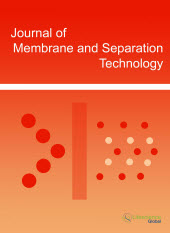jmst
Abstract : Evaluation and Comparison of Sulfate Anions Removal from Artificial and Industrial Wastewaters by Nanofiltration Process in a Laboratory Scale
|
|
Abstract: In this study, the performance of a nanofiltration process in sulfate anion reduction from artificial and industrial wastewaters was investigated. For this purpose, the effects of pressure, temperature, and volume flow rate and sulfate concentration of feed were studied. In order to prepare artificial wastewater (i.e. Sodium Sulfate) and to adjust the pH of the feed, both Sodium Hydroxide and Acetic Acid were used. The concentration of sulfate in the artificial wastewater was in the range of the industrial one (i.e. 400~500 ppm) and the pressure range, which had the most important influence on retention, was between 138~552kPa. In order to organize the experiments and obtain a specific procedure to perform the required tests, Minintab 16 software has been utilizes. The results showed that the reduction of sulfate anions, which had bivalent charge with big molecule size, occurred at high level of 96~99%. Higher pressure and temperature led to increase in this retention rate, while it reduced at high level of sulfate concentration in the feed. The condition in which the pressure, temperature, and feed flow rate were respectively 50345 kPa, 25ºCand 4L/min were indicated as the optimum condition. Keywords: Sulfate anion, Industrial wastewater, Nanofiltration, Removal. Download Full Article |
Abstract : Managing Hazardous Municipal Wastewater: A Membrane-Integrated Hybrid Approach for Fast and Effective Treatment in Low Temperature Environment
|
|
Abstract: Protection of natural water resources like lakes from the onslaught of hazardous municipal wastewater is often a challenge particularly in the cold regions. For treatment of enormous quantity of municipal wastewater, biological treatment is normally adopted but high COD (Chemical Oxygen demand) of such wastewater turns biological treatment slow and difficult. At low temperature environment, effective treatment of such municipal wastewater becomes extremely difficult due to weakened microbial activities. The present study was carried out with a hybrid approach comprising chemical treatment and membrane separation under psychrophilic conditions. Well–known Fenton’s treatment was adopted under response surface optimized conditions that helped recovery of nitrogen and phosphorus nutrients as value–added struvite fertilizer or magnesium ammonium phosphate (NH4MgPO4∙6H2O). The optimal COD removal was found to be 96% at a low temperature of 15oC and pH of 6.3 using Fe2+/H2O2 ratio of 0.10 and of H2O2 1.9 g/l with reaction time of 2 h. Down–stream purification of the struvite-free water by microfiltration and nanofiltration largely fouling–free flat sheet cross flow membrane modules ultimately turned the treated water reusable through reduction of dissolved solids, conductivity and salinity. Keywords: Municipal wastewater, Low temperature treatment, Central composite design, Fenton’s treatment, membrane filtration. Download Full Article |
Abstract : High Hydrogen Permeance Silica Membranes Prepared by a Chemical Vapor Deposition Method
|
|
Abstract: H2 permselective silica hybrid membranes were successfully prepared by using a counter diffusion chemical vapor deposition (CVD) method. Hexyltrimethoxysilane (HTMOS), phenyltrimethoxysilane (PhTMOS) or diphenyldimethoxysilane (DPhDMOS) were used as silica precursors. The oxidants were O3 or O2. These reactants were provided at the opposite side of the γ-alumina substrates, and the deposition occurred in the pores of the substrates. The HTMOS/O3 derived membrane deposited at 450°C showed the highest H2 permselectivity. The H2 permeace was 2.1×10-6 mol m-2 s-1 Pa-1 with the H2/SF6 permeance ratio of 5.9×106. H2 permeances through the HTMOS derived membranes increased with increasing the deposition temperatures. While the H2 permeance through the PhTMOS and DPhDMOS derived membranes decreased with increasing the deposition temperatures. The PhTMOS derived membrane prepared at 150°C showed the H2 permeance of 1.7×10-6 mol m-2 s-1 Pa-1 with the H2/SF6 permeance ratio of 13. The PhTMOS membrane prepared at 320°C showed the highest H2/SF6 permeance ratio of 1.8×104among the PhTMOS derived membranes. However, the H2/SF6 permeance ratio through the DPhDMOS membranes showed the different trend. Higher H2/SF6 permeance ratio was found through the DPhDMOS derived membranes deposited at 180°C and 360°C. The maximum H2/SF6 permeance ratio was 4.2×104 through the DPhDMOS membrane deposited at 180°C. The decomposition properties of organic groups on silica surface are investigated by using hydrolysis powders derived from the each silica precursor. The HTMOS powders showed O3 stability after the high temperature treatment. Thus, high H2 permselective membranes were prepared by the HTMOS at 450 °C. Keywords: Silica hybrid membrane, counter diffusion CVD method, H2permselective membrane, pore size control, silica precursors. Download Full Article |
Abstract : A Pilot-Plant Test of a Membrane Bioreactor with a Novel Membrane Made from Chlorinated Poly (Vinyl Chloride) (CPVC) and Hydroxy-Propyl Cellulose
|
|
Abstract: A pilot-plant test that can treat an amount of 30 ton per day of wastewater is performed. The purpose of this test is to prove the usefulness and applicability of newly developed microfiltration membranes made from chlorinated poly (vinyl chloride) and polyester nonwoven. Here, the hydrophilicity of membranes is important and hydroxyl-propyl cellulose is used to mitigate their hydrophobicity. The membrane consists of the novel structure in which small particles made from hydroxyl-propyl cellulose gel are homogeneously dispersed and attached on the surface of micro fibrils in the structure. The result of the pilot-plant test shows that the newly developed membrane has anti-fouling properties better than that of a conventional membrane made from chlorinated poly (vinyl chloride) by another company. It still shows high hydrophilicity after the use of one year, while the conventional one loses such properties. Saving electricity in producing water is one of important issues in developing membrane bioreactor systems and the case in use of newly-developed membranes is revealed to need 2.0 kWh of electricity to produce 1 m3 of filtered water. This amount is fairly good and reasonable when the pilot-plant test is considered to belong to a medium-size facility. Keywords: MBR, chlorinated poly(vinyl chloride), hydroxy-propyl cellulose, fouling, hydrophilicity. Download Full Article |






















